September-December 1944
The penultimate post. Famous Studios has started to find its identity—sometimes for the better, but mostly for worse.
By the time these saw print, Terry-Toon veterans Johnny Gent, Marty Taras, and Bill Tytla had joined the Famous staff and their skill was rapidly influencing the look and movement of the pictures. The appealing Terry house style blended with the principles Tytla developed at Disney’s. (Although Gent said director Terry director Connie Rasinki would screen prints of Disney cartoons for the Terry animators to study.) And thus came the pleasant but cookie-cutter Famous house style that stayed well through 1956.
On the promo pieces below, it’s interesting to note the November 26th cartoon, Lulu In The Dark. Nice gag with Tubby, but it was never an animated short. The two “Noveltoons” rated a photo of a cel set-up (as opposed to an original drawing): the long threatened awaited Spunky cartoon and Gabriel Churchkitten (the full cartoon is embed below). For the first few years the Noveltoons were treated as something special amongst the Lulu and Popeye releases by Famous, each one based on a pre-sold property or original character.
Note they reprinted the Lulu “Happy New Year” gag from the year before – not even updating the year (1944), thus negating the “joke”. Also compare She Sick Sailors (embed below) with its December 28th promotional cartoon. The print gag has nothing to do with the film and its tie-in to Superman – and yet makes more sense of the title than the short itself!





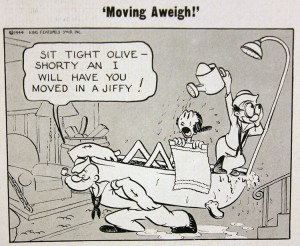

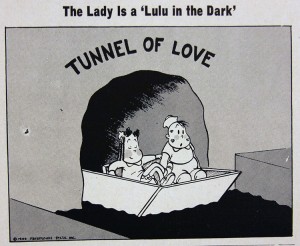

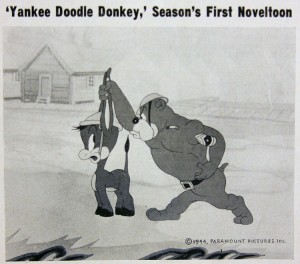
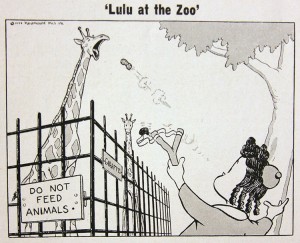


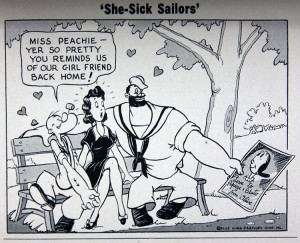
 THAD KOMOROWSKI is a writer, journalist, film restorationist and author of the acclaimed (and recently revised) Sick Little Monkeys: The Unauthorized Ren & Stimpy Story. He blogs at
THAD KOMOROWSKI is a writer, journalist, film restorationist and author of the acclaimed (and recently revised) Sick Little Monkeys: The Unauthorized Ren & Stimpy Story. He blogs at 

























































Yeah, the title “She-Sick Sailors” makes no sense. It would seem that they had a completely different cartoon initially in mind, but then went for the Superman-themed episode instead without ever bothering to change the title or title card. Which seems like a major blunder considering what a draw such a tie-in would have been.
That Little Lulu short is bizarre as one of those cartoons where a human character that is normally known for interacting in a strictly human world is suddenly having conversations with Hollywood anthropomorphic animals. In this case it’s like they stitched two different Famous shorts together to make one bizarre hybrid short..
It’s also of note that around this period it seemed that the famous storymen were trying to turn Little Lulu into a cutesy knock-off of Droopy.
Yeah, the title “She-Sick Sailors” makes no sense. It would seem that they had a completely different cartoon initially in mind, but then went for the Superman-themed episode instead without ever bothering to change the title or title card. Which seems like a major blunder considering what a draw such a tie-in would have been.
Yeah, very cheap and misleading. I suppose they couldn’t figure out a clever title to tie-in the superhero angle the cartoon now took.
That Little Lulu short is bizarre as one of those cartoons where a human character that is normally known for interacting in a strictly human world is suddenly having conversations with Hollywood anthropomorphic animals. In this case it’s like they stitched two different Famous shorts together to make one bizarre hybrid short..
That’s true, of course Famous was no stranger to that just a year or two earlier with the Popeye cartoon “A Jolly Good Furlough”. It seemed like the rules were throw out the widow that time until they started clamping down on that sort of detail, at least the “funny animals” left Lulu and Popeye alone after this point.
It’s also of note that around this period it seemed that the famous storymen were trying to turn Little Lulu into a cutesy knock-off of Droopy.
She certainly came off like that in ones like “Snap Happy”.
The cartoons may have looked better by the end of 1944, but the looming return of the Screen Songs would be the first sign that Famous’ trajectory was on the downhill side. Not only by going back to the Fleischer standby, but returning to those efforts spot-gag formats that had been pretty much abandoned by 1945 at the other studios, it showed a problem the studio had in developing continuing characters and/or with varied story lines — which Famous would eventually try to solve when they did hit on an appealing character, by repeatedly using the same story line that worked the first time around.
What, no embed of “Yankee Doodle Donkey”? After all that build-up, we’re deprived of Spunky’s glorious return?
I kid, of course, but still, I’d say it was a better short than “Gabriel Churchkitten”.
“Gabriel Churchkitten” is THE example of what went wrong at Famous in 1944. In the studio’s quest for respectability, they dropped a great approach to cartoon film-making seen in the best 1943-mid ’44 cartoons.
This thing is long, talky and repetitive. Some fine animation and weird character design (for Peter, the mouse) are wasted on a dull, un-cinematic cartoon. The Famous quirks that occasionally appear only make the film worse–they call attention to its dullest, most prosaic aspects.
Famous was onto something at first. It’s heartbreaking to see that magic slip out of their grasp, in the service of blander, less lively product.
Definitely in agreement there. It’s purely comedic shorts were still fairly solid for some years later, but they too would fall into the trap of overall blandness.
“Gabriel Churchkitten” is THE example of what went wrong at Famous in 1944. In the studio’s quest for respectability, they dropped a great approach to cartoon film-making seen in the best 1943-mid ’44 cartoons.
That zany, goofiness of the Popeyes during the final B&W years certainly faded from this point on.
This thing is long, talky and repetitive. Some fine animation and weird character design (for Peter, the mouse) are wasted on a dull, un-cinematic cartoon. The Famous quirks that occasionally appear only make the film worse–they call attention to its dullest, most prosaic aspects.
Probably not the best kids’ book to adapt in the first place, though to be fair, the design of Peter wasn’t too far off from when the book illustrations had, but yeah, not terribly close to Margot Austin’s work the way they were designed but those are the limitations I’m sure of the time.
http://ecx.images-amazon.com/images/I/91UBaHhObZL.jpg
Famous was onto something at first. It’s heartbreaking to see that magic slip out of their grasp, in the service of blander, less lively product.
Just imagine what they could’ve done with Ludwig Bemelman’s “Madeline” instead? (I can’t, be thankful someone else picked that up a decade later).
Die, Spunky!
Did Tubby appear in the Lulu cartoons? It’s been so long since I’ve seen one I can’t remember.
Tubby makes a cameo in Lulu’s Birthday Party and appears as “Fatso” in Beau Ties (voiced by Arnold Stang!). Tubby also appears in the two 1960s Paramount cartoons Alvin’s Solo Flight and Frogs Legs.
Tubby is also in Bored of Education and Musica-Lulu.
Tubby also gets a cameo running out of the schoolhouse at the end of “A Bout for A Trout”.
Tubby also puts in a brief appearance in “It’s Nifty To Be Thrifty”.
https://www.youtube.com/watch?v=aqaHKbVWiC8
(Another gorgeous print from a German DVD.)
At least you can’t say they didn’t use Tubby all that much, but certainly didn’t find much avenues to explore with him the way a certain John Stanley would do with the character soon enough.
Lulu a human version of Droopy? Somehow, I can’t see that. I just thought of her as a female version of Spanky from the OUR GANG comedies, that kid always kind of in the way but ending up proving the adults around her inadequate in their way of thinking. I see what all of you are saying about how whatever was going on at the Paramount Studios eventually destroying most hints of creativity at Famous Studios, but I liked the LULU series. The best of those cartoons don’t usually show up on the usual PD tapes or disks; taht’s why I always wanted the entire series issued on DVD’s. Shame that the Paramount cartoons weren’t given the unlimited budgets that the MGM Harman/Ising cartoons got, because I would have loved to see what animators would have done with it.
I assume they’re referring to this cartoon, which has moments reminiscent of “Dumb Hounded” (and the yet-to-come “Northwest Hounded Police”).
https://www.youtube.com/watch?v=6uzO3sPO-zQ
An interesting ‘What if?” for Famous is what would have happened if Paramount had ponied up the money to keep the Lulu series going. The Little Audrey cartoons followed some of the basic formula, but where both series based a number of cartoons on dream sequences, the ones in the Lulu efforts showed far more creativity than what the Audrey series sank into by the second year of production (the Audreys also shied away from stories pitting her against an adult male authority figure who could then be set up for slapstick punishment. Those tended to be the best of the Lulu series, and while they did some with Audrey, it wasn’t nearly enough to overcome the dreary dream sequence formula by the early 1950s).
I assume they’re referring to this cartoon, which has moments reminiscent of “Dumb Hounded” (and the yet-to-come “Northwest Hounded Police”).
The Little Lulu cartoon “Snap Happy” follows this formula a bit.
https://www.youtube.com/watch?v=6uzO3sPO-zQ
“Gabriel Churchkitten” – also known as “Gabriel Blows”. It should live on in memory as a formidable candidate for the WTF Hall of Fame.
Tytla and company may have taught the crew at Famous how to do Disney-style personality animation, but the lesson not taught and the glaring problem with the Famous characters is they lack anything resembling a (other than rudimentary and forgettable) personality at all. Even “Little Lulu” is dull in their hands. RE: “Gabriel Churchkitten” – who exactly were they making this cartoon for?
The Superman comic book Olive reads in “She-Sick Sailors” has painted art – something no Golden Age comic I know of had (as far as interior art), at least no DC titles of that era. They obviously assigned that to the background (or in Famous-ese, “scenics”) artist instead of one of the animators.
The Superman series had ended in 1943. It’s tempting to speculate they still had the rights to make one more, and “She-Sick Sailors” was one last chance to legally exploit Superman’s name and likeness. Even if the contract was legally ended, some form of permission had to be involved or Superman would have been disguised with a parody name.
The cartoon is mainly Bluto playing Superman as a jerk, and being more despicable than usual — machine-gunning Popeye, for pity’s sake. This could be taken as the studio thumbing its nose as the comic book publisher. Was there any friction (or interaction at all) between Fleischer/Famous and National while the series was running? Today there’d be DC execs and lawyers reviewing every inch, but what about then?
Finally, why “She-Sick Sailors”? If National was aware of the cartoon — and I suspect they’d have to be — it’s plausible they demanded a title that didn’t mock or libel their hero, and perhaps vetoed any promotional art that showed Popeye fighting (and beating) a Superman lookalike.
It’s theoretically possible that the title was meant to help the cartoon fly under National’s radar, at least until it had nearly completed its theatrical run (remember that nobody was expecting these to have a shelf life). But then National/DC might well have caused it to be pulled from TV packages later.
So many questions I’m sure we’ll never know the answers to at all given the large amount of years that have passed since then.
Actually, “Yankee Doodle Donkey” isn’t a bad cartoon; it has some imaginative gags and a dandy music score. It’s easily better than most of the Fleischer Hunky-and-Spunky toons. As for “She Sick Sailors,” I don’t believe it was ever dropped from the Popeye TV package; and Paramount returned to the super-spoof idea a couple years later with “Super Lulu.”
I was listening carefully to the child actor playing Gabriel Churchkitten, and had a sudden notion about his identity. To me, it sounded strangely enough like a very young Dick Beals! Thad, Bob Camp, or any other animation historian with an expertise in Paramount Cartoon Studio historionics, please look into this. I’m curious as to who this young man could be!